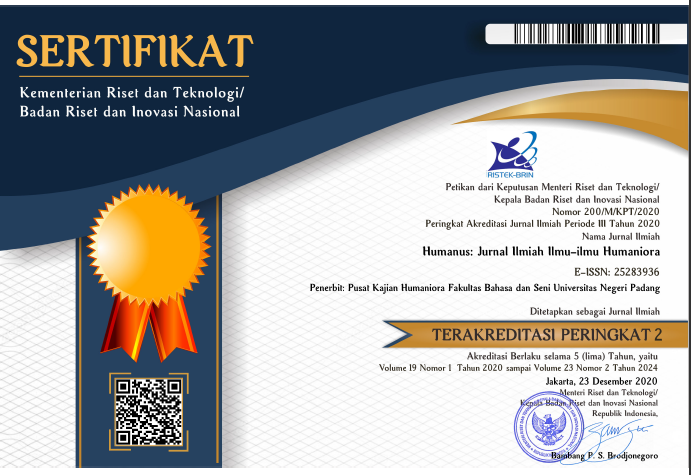Revitalizing Local Wisdom of Turi-Turian Folklore as a Reflection of the Angkola Ethnic Group
 ), Bambang Panca Syahputra(3),
), Bambang Panca Syahputra(3), (1) Universitas Muhammadiyah Sumatera Utara
(2) Universitas Prima Indonesia
(3) Universitas Muhammadiyah Sumatera Utara
 Corresponding Author
Corresponding Author
Copyright (c) 2021 Humanus
DOI : https://doi.org/10.24036/humanus.v20i2.114439
Full Text:
 Language : en
Language : en
Abstract
The 'turi-turian' folklore is assumed to be a bedtime story for children. Folklore has an essential message as an implied message for the reader or listener. Folklore is the ethnic creativity of traditional communities that maintains the culture and is firm in living traditions that are passed down from generation to generation. This study aims to highlight the local wisdom of the Sipirok tribal community through its folklore. This research uses qualitative research methods with ethnographic design, which includes data collection of folklore texts, data presentation, and drawing conclusions or verification. The data of this research is sourced from the analysis of data from Angkola folklore collected in the book ‘Turi-turn Nihalak Angkola Banggo-banggo’. This research reveals that folklore texts have a wealth of philosophical values that reflect the characteristics of indigenous peoples that have existed from the past until now which are still maintained as wisdom that is still upheld by indigenous communities. As one of the intangible assets of the Angkola Sipirok community, which has an ethnic culture, it is reflected in the characteristics of the Angkola Sipirok indigenous people who teach values as local wisdom. Based on the data analysis of the Sipirok ‘Turi-turian’ folklore, several local pearls of wisdom were found: persistence, hard work, deliberation, cooperation, social spirit, and willingness to help.
Keywords
References
Amri, Y. K., & Syahputri, D. (2020). The Local Wisdom of Angkola in Efforts to Love the Environment. Budapest International Research and Critics Institute (BIRCI-Journal): Humanities and Social Sciences, 3(3), 2053–2063. https://doi.org/10.33258/birci.v3i3.1131
Dundes, A. (1965). On computers and folk tales. Western Folklore, 24(3), 185-189.
Jeklin, A. (2016). Nilai-Nilai Edukatif Dalam Lirik Nyanyian Onang-Onang Pada Acara Pernikahan Suku Batak Angkola Kabupaten Tapanuli Selatan Provinsi Sumatera Utara. Bahasa, Sastra Dan Pembelajarannya, 1(July), 1–23. http://ejournal.unp.ac.id/index.php/bsp/article/view/5018/3970
Lubis, F. K., & Bahri, S. (2021). Enhancing Students’ Literacy Competence Through Writing Bilingual Folklore Book by IT: Process Approach. Randwick International of Education and Linguistics Science Journal, 2(1), 105–115. https://doi.org/10.47175/rielsj.v2i1.205
Manugeren, M., Sibarani, R., Nasution, I., & Takari, M. (2017). Local Wisdom in Hindu Tamil Ethnic Wedding Tradition in Medan. International Journal of Research in Humanities & Soc. Sciences, 5(2012), 38–48.
Moleong, L. J. (2007). Qualitative research methodology. Bandung, PT Remaja Rosdakarya, Year.
Nasution, M. R., Hadi, W., & Daulay, S. (2020). The Effectiveness of Teaching Materials Based on Local Culture on 7th Grade Students in Junior High School Sipirok. Budapest International Research and Critics in Linguistics and Education (BirLE) Journal, 3(1), 189–202. https://doi.org/10.33258/birle.v3i1.833
Nurgiyantoro, B. (2005). Sastra Anak Di Usia Awal dan Literasi. Diksi, 12(1).
Pérez-Lloréns, J. L., Mouritsen, O. G., Rhatigan, P., Cornish, M. L., & Critchley, A. T. (2020). Seaweeds in mythology, folklore, poetry, and life. Journal of Applied Phycology, 32(5), 3157–3182. https://doi.org/10.1007/s10811-020-02133-0
Prasetya, I. A., Tursina, T., & Safriadi, N. (2015). Penerapan Visual Novel Dari Cerita Rakyat Asal Usul Kota Pontianak. JUSTIN (Jurnal Sistem dan Teknologi Informasi), 4(1), 163-167.
Revika, R., & Hayati, Y. (2020). Categories, Structure, and Function of Folklore in Lima Puluh District Communities. RETORIKA: Jurnal Bahasa, Sastra, Dan Pengajarannya, 13(1), 137. https://doi.org/10.26858/retorika.v13i1.11303
Rodgers, S. (2013). Antic Histories: Narrating the Past in a Martinican Novel and a Sumatran Mock Family Memoir. Anthropological Forum, 16(3), 257–275. https://doi.org/10.1080/00664670600986837
Sahrul, S., & Fadhila Daulai, A. (2019). Kearifan Lokal Dalihan Na Tolu, Ninik Mamak Dan Kerapatan Adat Nagari Dalam Menjaga Kerukunan Antarumat Beragama Di Sumatera Barat Dan Sumatera Utara. MIQOT: Jurnal Ilmu-Ilmu Keislaman, 43(2), 300. https://doi.org/10.30821/miqot.v43i2.606
Sibarani, R. (2018). International Journal of Human Rights in Healthcare Batak Toba Society ’ s Local Wisdom of Mutual Cooperation in Toba Lake Area : A linguistic Anthropology Study. International Journal of Humanities and Social Science, 3.
Simanjuntak, D. H. P. E. . (2016). ANTHROPOS : Jurnal Antropologi Sosial dan Budaya Peranan Museum Simalungun sebagai Media Pewarisan Nilai Budaya. Jurnal Antropologi Sosial Dan Budaya 2, 2(2), 151–165.
Sinaga, A. (2012). Peran sastra etnis Batak dalam mengembangkan pendidikan karakter. Pena: Jurnal Pendidikan Bahasa dan Sastra, 2(1).
Zubia, M., Stiger-Pouvreau, V., Mattio, L., Payri, C. E., & Stewart, H. L. (2020). A comprehensive review of the brown macroalgal genus Turbinaria J.V. Lamouroux (Fucales, Sargassaceae). Journal of Applied Phycology, 32(5), 2743–2760. https://doi.org/10.1007/s10811-020-02188-z
 Article Metrics
Article Metrics
 Abstract Views : 1407 times
Abstract Views : 1407 times
 PDF Downloaded : 199 times
PDF Downloaded : 199 times
Refbacks
- There are currently no refbacks.
Copyright (c) 2021 Humanus

This work is licensed under a Creative Commons Attribution-NonCommercial 4.0 International License.










